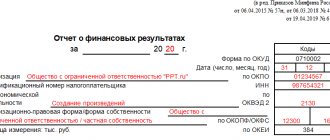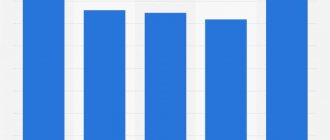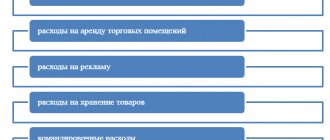If you are serious about getting into trading, you will have to choose which costing method to use. Such a seemingly simple question - how to write off sold goods - can have a serious impact on how your trade will develop. In this material we will look at all methods of cost calculation , evaluate the advantages of each, and also tell you when it is better to use which one.
Please note: it is more convenient to keep records and view analytics in the same program. The MoySklad goods accounting service has built-in reports on turnover, balances, profitability, and movement of goods. They are generated automatically and can be viewed at any time, for example, in a mobile application. No matter where you are: business is always under control. Register and try it now: it's free!
Try MySklad
The law allows three methods of assessment and calculation - by the cost of each unit of goods, by the average cost and by the FIFO method (English: “first in, first out”). Each of them will give different indicators for business profitability, and therefore for tax and management accounting. Let's figure out what the difference is.
At the cost of each unit
As the name implies, this method assumes that the cost of each specific product is taken into account in the calculations. This system is used when trading unique and expensive goods, when accuracy is important. For example, it is suitable for those who will sell cars, art or jewelry. It is logical that when a product is piecemeal, and one cannot easily replace another, exactly the price at which it was delivered is entered into accounting when writing off inventory items. This method also assumes that it is always clear from which specific delivery the goods sold came from.
Average cost method
It is used more often than the previous one, and involves monthly calculation of the cost of goods using the arithmetic average. In this case, it does not matter from which specific delivery this or that product “left”. This method of writing off inventory items is suitable for companies selling products for which piece accounting is not important. This could be, for example, stationery, clothing, shoes, toys, cosmetics and any other consumer goods. The average cost method is especially beneficial for those goods for which the price is constantly changing, both up and down.
This method is the easiest to account for. The average cost of goods is calculated using the following formula:
[average cost of inventory items] = ([cost of inventory items at the beginning of the month] + [cost of inventory items received during the month]) / ([number of inventory items at the beginning of the month] + [number of inventory items received during the month])
And the cost of inventory written off per month is calculated as follows:
[cost of written-off inventory items] = [average cost of inventory items] X [number of inventory items sold per month]
Example of calculation using the average cost method
At the beginning of the month, the Stationery store had 370 ballpoint pens left at a purchase price of 10 rubles. Within a month, another 1000 pens were delivered in two batches - 500 for 9 rubles 50 kopecks and 500 for 9 rubles. We calculate the average cost.
Cost of inventory items at the beginning of the month: 370 X 10 = 3700 (rub.) Cost of the 1st new supply of inventory items: 500 X 9.5 = 4750 (rub.) Cost of the 2nd new supply of inventory items: 500 X 9 = 4500 (rub.) Average cost of goods and materials: (3700 + 4750 + 4500) : (370 + 1000) = 9.45 (rub.)
This average cost will be used to calculate the written-off goods and calculate the profit. For example, if pens are sold for 15 rubles, and 1,100 pens were sold in a month, the profit specifically for these pens will be calculated as follows:
1100 X 15 – 1100 X 9.45 = 6105 (rub.)
The advantages of the average cost calculation method are the stability of the price of materials sold and simplicity. However, from a tax accounting point of view, it is not optimal in the case where, for example, you purchase the same pens from the same supplier, and he gradually reduces your prices. Let's consider the following option.
Formation of the actual cost of materials
| Type of expenses | Actual cost (cost) of materials | |
| Accounting | Tax accounting | |
| Amount paid to the material supplier | Include (clause 6 of PBU 5/01) | Include (clause 2 of article 254 of the Tax Code of the Russian Federation) |
| Expenses for information and consulting services related to the purchase of materials | Include (clause 6 of PBU 5/01) | Include (clause 2 of article 254 of the Tax Code of the Russian Federation) |
| Customs duties and fees | Include (clause 6 of PBU 5/01) | Include (clause 2 of article 254 of the Tax Code of the Russian Federation) |
| Costs for procurement and delivery of materials to the place of their use, including insurance costs | Include (clause 6 of PBU 5/01) | Include (clause 2 of article 254 of the Tax Code of the Russian Federation) |
| Costs of bringing materials to a state in which they are suitable for use | Include (clause 6 of PBU 5/01) | Include (clause 2 of article 254 of the Tax Code of the Russian Federation) |
| Intermediary fees and other costs directly related to the acquisition of materials | Include (clause 6 of PBU 5/01) | Include (clause 2 of article 254 of the Tax Code of the Russian Federation) |
| Amounts of VAT and excise taxes in cases where materials are used for transactions subject to these taxes | Do not include (clause 6 of PBU 5/01) | Do not include (clause 2 of article 254 of the Tax Code of the Russian Federation) |
| Amounts of VAT and excise taxes in cases where materials are used for transactions not subject to these taxes | Include (clause 6 of PBU 5/01) | Includes (clause 2 of article 170, clause 2 of article 199, clause 2 of article 254 of the Tax Code of the Russian Federation) |
| Amounts of other taxes and fees (for example, contributions to compulsory pension (social, medical) insurance) | Include (clause 6 of PBU 5/01) | Include (clause 2 of article 254 of the Tax Code of the Russian Federation) |
| Interest on credits (loans) accrued before the materials were accepted for accounting | Include (clause 6 of PBU 5/01) | Not included (subclause 2, clause 1, article 265 of the Tax Code of the Russian Federation - non-operating expenses) |
| Interest on credits (loans) accrued after acceptance of materials for accounting | Do not include (clause 6 of PBU 5/01) | Not included (subclause 2, clause 1, article 265 of the Tax Code of the Russian Federation - non-operating expenses) |
| Differences associated with the purchase of materials, the cost of which is expressed in foreign currency, but payment is made in rubles | Do not include (paragraph 4, paragraph 3, paragraph 5 and 13 of PBU 3/2006 - other expenses or income) | Not included (subclause 5.1, clause 1, article 265 of the Tax Code of the Russian Federation - non-operating expenses, clause 11.1 of article 250 of the Tax Code of the Russian Federation - non-operating income) |
| Differences associated with the purchase of materials for foreign currency | Do not include (paragraph 4, paragraph 3, paragraph 13 of PBU 3/2006 - other expenses or income) | Not included (subclause 5, clause 1, article 265 of the Tax Code of the Russian Federation - non-operating expenses, clause 11, article 250 of the Tax Code of the Russian Federation - non-operating income) |
If an organization independently produces materials, then these costs are included in the actual cost only if the accounting policy provides for their inclusion in direct costs (clause 4 of Article 254, clause 2 of Article 319 of the Tax Code of the Russian Federation).
FIFO method. Calculation example
This is the most popular cost calculation method. It uses the queuing principle. It is assumed that the items that were delivered first are written off first. Hence the name FIFO method (English: “first in, first out” - “first in, first out”). However, unless the shelf life is important, it is not necessary to ship goods from an earlier delivery first - this is used as an assumption in the calculations. That is, the cost of goods that are sold first is calculated at the price of the balances from the “oldest” delivery. When the balances are quantitatively exhausted, inventory items are written off at the price of the next delivery, then the next one, and so on.
Example of calculation using the FIFO method
Let’s take our “Stationery” store with ballpoint pens and exactly the same situation as above. We have 370 ballpoint pens for 10 rubles and are supplied in two batches of 500 pens - first for 9 rubles 50 kopecks, then for 9 rubles. 1100 pens sold for 15 rubles. We count the profit.
The first to go will be 370 pens at 10 rubles each - that’s 3,700 rubles. Next, 500 pens cost 9.5 rubles each, which is another 4,750. There are 230 pens left, each priced at 9 rubles, which is 2,070 rubles.
1100 X 15 – (3700 + 4750 + 2070) = 5980 (rub.)
As can be seen from the example of calculation using the FIFO method, the profit indicator in this case is lower than in the example with average cost. Accordingly, income tax will be less.
Calculation of production costs: methods
In practice, calculating product costs can be complicated by various factors. For example, an enterprise may produce 100 or more different products, for each of which it is necessary to create its own cost. In this regard, specialists have to make serious mathematical calculations. But farmer Ivan Sergeevich does not want to make complex calculations - he wants to sell his vegetables profitably.
To facilitate the calculation process, organizations use narrower calculation methods, depending on the efficiency of control at the enterprise and the objects of accounting for the estimated costs. Based on these indicators, the following methods are used:
- normative;
- process-by-process;
- transverse;
- custom.
Each has its own sequence of actions. The final cost will also differ.
Normative method
When applying the standard method for calculating cost, you must be guided by the following principles:
- For each product produced, it is first necessary to carry out a standard cost calculation;
- to make the results more reliable, they are adjusted within a month, assessing the work at the enterprise;
- all available actual costs for this month are calculated item by item, compared with standards, deviations are identified (excess, deficiency);
- a search is made for the causes of any deviations;
- The actual cost is determined, compared with the standard cost, and conclusions are drawn regarding the operation of the enterprise.
This method is used to evaluate the performance of an enterprise. There is no universal formula for it, since enterprises may have different cost items. The rationing process is long and painstaking. But as a result we can determine:
- which workshops are working efficiently and which are not;
- what are the results of work for the reporting period;
- how to improve the operation of the enterprise, what costs to reduce.
This calculation method can rightfully be considered the most complex and time-consuming, since in addition to calculating the actual cost, you also need to calculate the standard cost, compare them, and analyze the results. Typically, this method is used by large enterprises and they hire specially trained people for calculations, so this method is not suitable for Ivan Sergeevich.
Process method
For enterprises engaged in the production of several types of products at once, it is best to use the process method.
In its classic form, it is relevant for industries with the following characteristics:
- mass production;
- more than one type of product is produced;
- the technological process is short in time;
- there is no work in progress or the volume of semi-finished products is very small;
- The same characteristics apply to all types of products.
Most often, the process-by-process method of calculating cost is used in the mining, transport and energy industries.
The methodology itself for cost accounting and cost calculation uses the final product as an object. All direct and indirect costs of the enterprise are calculated item by item and calculated for the entire volume of production. After this, the average cost per unit of goods is determined by dividing the total costs for the month by the volume of finished products.
The essence of the technique is contained in its name. The entire production cycle is divided into processes. The product cost formula may vary across enterprises. Therefore, there are two types of calculation:
- one-step;
- two-stage.
One-step
One-step is used in cases where the company does not have stocks of finished products. Then the simplest formula is used for calculation:
Unit Cost = Total Costs/Quantity of Goods Produced
Moreover, not only pieces, but also kilograms, meters and other units of change can be used as the quantity of goods produced.
Two-stage
This method already includes calculations related not only to manufactured, but also to sold products. In this case, the cost is determined as follows:
Unit cost = (Manufacturing costs/Number of goods produced) + (Non-manufacturing costs/Number of goods sold)
As a result, the calculations take into account the efficiency of production and sales of products, which ultimately determines the cost. This value may vary from month to month. For example, during seasonal times, costs may decrease due to increased sales.
Calculation of the cost of cucumbers
The two-step method is just right for calculating the cost of production for farmer Ivan Sergeevich. Let's calculate the cost of cucumbers. What will be the cost in different months, based on the process method? Let's make calculations for 3 months in tabular form:
| December | March | June | |
| Volume of products produced | 1,000 kg. cucumbers | 2,000 kg. cucumbers | 2,000 kg. cucumbers |
| Production costs | 100,000 rubles | 150,000 rubles | 150,000 rubles |
| Volume of products sold | 500 kg. cucumbers | 1,200 kg. cucumbers | 1,800 kg. cucumbers |
| Non-production costs | 15,000 rubles | 15,000 rubles | 15,000 rubles |
| Cost price | 100 000/1 000 + 15 000/500 = 100 + 30 = 130 rub/kg | 150 000/ 2 000 + 15 000/1 200 = 75 + 12,5 = 87.5 rub/kg | 150 000/ 2 000+ 15 000/1 800 = 75 + 8,34 = 83.34 RUR/kg |
As can be seen from the example, high demand for products provoked a decrease in production costs per unit of output. Product prices are often determined based on this cost.
Transverse method
This calculation method is used in those enterprises where raw materials go through several stages of processing, becoming finished products. The redistribution in this case is a certain sequence of operations of the technological cycle. There may be several such redistributions. For example, wood is first processed, then cut and pressed. Each of these processes can be called a redistribution. In fact, the output of such a chain is a semi-finished product, which is then transferred to another workshop for subsequent processing.
It makes sense to use the incremental cost calculation method for enterprises that have the following characteristics:
- one or more varieties of finished products are produced;
- large volumes of products;
- each worker has his own narrow specialization (that is, one is engaged in processing, another in trimming, a third in pressing, and so on);
- availability of high-tech automated equipment at the enterprise.
If production is on stream, then this technique is ideal. For example, it is being implemented in the metallurgical, chemical, and pulp and paper industries.
The object of accounting in this case is redistribution. Costs are calculated for each stage and then summed up. In the absence of a large number of unsold products, you can use the modified formula of the two-stage process method. Only in addition, both types of costs will be divided into different stages.
If there is a surplus, the conventional units method is needed. The object of calculation here is already material and additional costs. The difficulty lies in the fact that you will have to take into account the amount of finished and unfinished products at each processing stage, and divide the costs between these stages of production.
Custom method
Enterprises with a single type of production should use the order method. This also includes serial production of unique products for special orders. The use of the custom method is relevant in aircraft and shipbuilding companies. It is widely used in small businesses. If an entrepreneur does not know how to calculate the cost of a service, the best option for him would be the custom method. This is especially true for services that are provided in different volumes. For example, advertising and auditing services.
The custom method should be used if production has the following characteristics:
- a large list of finished products or services provided;
- small volumes of production within specific services/products;
- availability of unified documentation for orders (costing cards, for example);
- use of universal equipment suitable for the production of different types of products.
The accounting object when using this method is the order. Within the framework of it, calculation is carried out. A special feature of the order method is that accounting of goods and services is carried out only after their direct payment. That is, if a service was provided to a client, but payment has not yet been received, then it cannot be taken into account. In this case, the order is included in work in progress.
The use of the order-by-order method is precisely based on cost calculation for different orders. From a calculation point of view, this is simpler than summing up all costs and calculating the average cost. In addition, such a cost will be unreliable and uninformative, because one order can cost an impressive amount of money, and another - 10 times less.
FIFO or average cost - which is better?
Both of these methods work quite well. However, FIFO is considered more accurate than the average cost method. It is especially beneficial in terms of taxes if the price of the goods you purchase is constantly decreasing. Then the cost of the written-off goods will be the greatest, and the balance will be the minimum. Therefore, the answer to the question of which is better, FIFO or average cost, in most cases will be the first option.
FIFO method in warehouse program
Despite the fact that the FIFO method is quite simple in terms of understanding the principle of its operation, manually calculating the cost each time is very labor-intensive. Especially if you have a small business, and you yourself are the director, the cashier, the accountant, and the chief buyer. It is much easier if you simply enter data on deliveries and sales and immediately get the result. This is exactly how you can work with the MyWarehouse service. The program fully automates trading processes and itself calculates the cost of written-off goods using the FIFO method. MyWarehouse calculates profitability for each product or product group, stores and displays current and historical balances, as well as many other data that may be useful. This way, you save time and can be confident in the accuracy of the indicators on which you make decisions.
Company accounting policy
According to the law, the organization itself chooses how to calculate the cost of goods. It is important that the method you consider is necessarily reflected in the company's accounting policies. This is stated in Article 313 of the Tax Code of the Russian Federation, as well as in paragraph 73 of the Methodological Instructions approved by Order of the Ministry of Finance of Russia dated October 28, 2001 No. 119n.
Changes to accounting policies can be made once a year. That is, you can deposit them earlier, but they will take effect according to the law next year - at the beginning of the new tax period. The accounting policy is drawn up by an accountant and approved by the head of the organization.
For management accounting purposes, you are free to use any costing method. Our advice is to use the same one that is written down in your accounting policy - this way there will be less confusion.
ACCOUNTING FOR RECEIPT OF MATERIALS AT ACTUAL COST (ENTRY, EXAMPLE)
If inventory items are accepted for accounting at actual cost, then they are immediately debited to account 10 at the cost indicated in the supplier’s documents. If the organization is a VAT payer, then the tax amount is allocated for reimbursement from the budget to a separate sub-account. Postings when accounting for materials at actual cost are as follows:
| Debit | Credit | Operation name |
| 60 | 51 | The cost of received goods and materials was paid to the supplier |
| 10 | 60 | Inventory and materials are accepted for accounting at actual cost excluding VAT |
| 19 | 60 | VAT is allocated from the cost of inventory items |
Transportation and procurement costs (TPC) when purchasing materials in accounting can be taken into account in different ways:
- Can be included in the actual cost of materials on account 10.
- May be reflected in a separate subaccount of account 10.
- Can be taken into account on account 15.
The organization chooses one of these methods of accounting for transportation and procurement costs and reflects this in the accounting policy order
EXAMPLE OF ACCOUNTING FOR RECEIPT OF MATERIALS WHEN PURCHASING
| The organization Alpha LLC purchased 5,000 cubic meters of parquet for 600,000 rubles. including VAT 91,525. For delivery they paid 6,000, including VAT 915 rubles. 3,000 cubic meters of parquet were put into production. These transactions must be reflected on the balance sheet. Note: (How VAT is calculated from the amount can be found in the article: “How to calculate VAT. VAT tax rates.”). Transport and procurement work is accounted for on account 10 of the TZR subaccount. |
Postings for accounting for receipt of materials upon purchase
| Sum | Debit | Credit | Operation name |
| 600000 | 60 | 51 | Paid the cost of parquet |
| 508475 | 10 | 60 | Parquet was capitalized excluding VAT |
| 91525 | 19 | 60 | VAT allocated |
| 6000 | 60 | 51 | Delivery paid |
| 5085 | 10 subaccount TZR | 60 | Parquet delivery costs taken into account |
| 915 | 19 | 60 | VAT allocated |
| 360000 | 20 | 10 | Materials written off for production |
| 360000 | 20 | 10 subaccount TZR | TZR written off for production |
TZR are written off once a month in one transaction. To determine the amount of write-off of transportation and procurement costs, the following ratio is determined:









